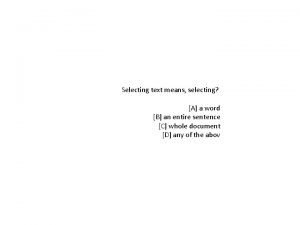Selecting grass species to reduce GHG emissions RESAS

- Slides: 1

Selecting grass species to reduce GHG emissions RESAS funded Strategic Research Programme: RD 1. 1. 1; Soil and its ecosystem function Introduction Through the Climate Change (Scotland) Act 2009, Scotland seeks by 2050 to reduce greenhouse gas (GHG) emissions by 80% compared to baseline 1990 levels. Opportunity One possible way to reduce net emissions in the Scottish agricultural sector is through the smart selection of crop species (including varieties/cultivars) that reduce soil GHG emissions. Our research focus has been on grassland that represents 23% , c. 1. 3 Million ha, of the total agricultural land in Scotland (2017 Agricultural Census) but does not include a further c. 600 k ha of common grazing. By sector, agriculture in Scotland is the third largest source of net emissions (Figure 1). Preliminary Results Laboratory results studying 10 grass varieties selected from the national recommended list exhibited substantial differences in soil GHG emission levels (Figure 3). Figure 1. Sources of Scottish Greenhouse Gas Emissions (2015). Values in Mt. CO 2 e. (Scottish Greenhouse Gas Emissions 2015, Climate Change Statistics, Edinburgh, June 2017) Agriculture in Scotland has reduced net emissions by approximately 25% since 1990 (Figure 2). Figure 2. Change in net emissions by SG sector between 1990 -2015 in Mt. CO 2 e and associated percentage change. (Scottish Greenhouse Gas Emissions 2015, Climate Change Statistics, Edinburgh, June 2017) Acknowledgements This research is a collaboration between Roy Neilson (roy. neilson@hutton. ac. uk), Madeline Giles (maddy. giles@hutton. ac. uk) and Eric Paterson (eric. paterson@hutton. ac. uk) based at the James Hutton Institute. Space for Fig. 3 The results are exciting but we now need to determine whether this can be replicated under field conditions. To facilitate this, a new grass research platform (Figure 4) has been established at the James Hutton Institute. A robust experimental design with a range of treatments including single and mixed species will be studied for their GHG emissions. Maddy please add some high level text here – max. 2 sentences I think. Space for Fig. 4 Conclusions § Our preliminary research has shown that grass species from the National Recommended List emit significantly different levels of GHG. § If this is replicated in the field, there is a clear opportunity for the smart selection of varieties thus helping the agricultural sector in Scotland to contribute to national emission targets.

